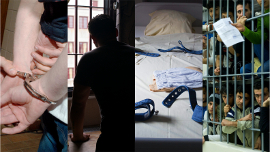The CPT heard no allegations of recent ill-treatment during custody in police establishments. However, a few allegations were received from detained persons (including juveniles) that they had been subjected to excessive use of force by police officers at the time of apprehension (in particular, punches and kicks). As to the continued use of four-point Fixierung (the physical fixing to a bed or mattress) of agitated and/or violent detained persons in police establishments, the Committee has recommended that the authorities put an end to this practice. In their response, the German authorities state that the practice of Fixierung in a police context has been abolished in many of the Länder, but continues to be applied in some Länder in rare, exceptional cases.
One of the objectives of the visit was to examine in detail the conditions of detention in units for immigration detainees in prisons. In this connection, the CPT was particularly concerned about the situation found at Munich-Stadelheim Prison, where immigration detainees were subjected to severe restrictions regarding visits and access to the telephone. In their response, the German authorities state that immigration detainees in Munich-Stadelheim Prison have now been granted more frequent access to the telephone and at least one visit of one hour per week. They further informed the Committee that renovation work has been carried out in the unit for male immigration detainees.
The CPT received several allegations of inter-prisoner violence (beatings, threats and extortion), mainly from juveniles at Cologne, Herford and Leipzig Prisons. The Committee noted that efforts were being made to counter this phenomenon and has invited the authorities to remain vigilant in this regard. The Committee also criticised the fact that prisoners, including juveniles, were occasionally subjected to means of physical restraint (Fixierung) for prolonged periods, and has reiterated the safeguards that should surround any application of Fixierung in the context of prisons. The Committee has also stressed that the aim should be to abandon the resort to Fixierung in non-medical settings.
Particular attention was paid to the situation of persons subject to preventive detention (Sicherungsverwahrung) at Burg, Freiburg and Schwäbisch Gmünd Prisons. The visits took place at a time when the entire system of preventive detention in Germany was undergoing a major reform, in the light of recent judgments of the European Court of Human Rights. The CPT found that the differentiation between preventive detention and prison sentences (Abstandsgebot) was not always effectively implemented and that there was a shortage of psychological care and therapeutic activities. However, the Committee has welcomed the concrete measures being taken to improve the situation, notably at Freiburg Prison; namely, the transfer of persons in preventive detention to a new building with a less carceral infrastructure, the significant increase of staff as well as newly developed special “motivation programmes” and therapeutic activities.
At the Rheine Forensic Psychiatric Clinic, the CPT gained a generally favourable impression of the living conditions and treatment provided to patients.
The CPT report also notes that surgical castration is applied in a few German Länder in rare, isolated cases. The Committee makes clear its fundamental objections to the use of surgical castration as a means of treatment of sexual offenders and has recommended that it be discontinued. In their response, the German authorities state that they are currently reviewing the matter.
Both documents have been made public at the request of the German Government and are available (in English and German) on the CPT’s website: http://www.cpt.coe.int
2012 News
The Council of Europe's Committee for the Prevention of Torture and Inhuman or Degrading Treatment or Punishment (CPT) published today the report on its most recent visit to Germany, in November/December 2010, together with the response of the German authorities.
22/02/2012
- Diminuer la taille du texte
- Augmenter la taille du texte
- Imprimer la page

Preventing torture in Europe
www.cpt.coe.int


